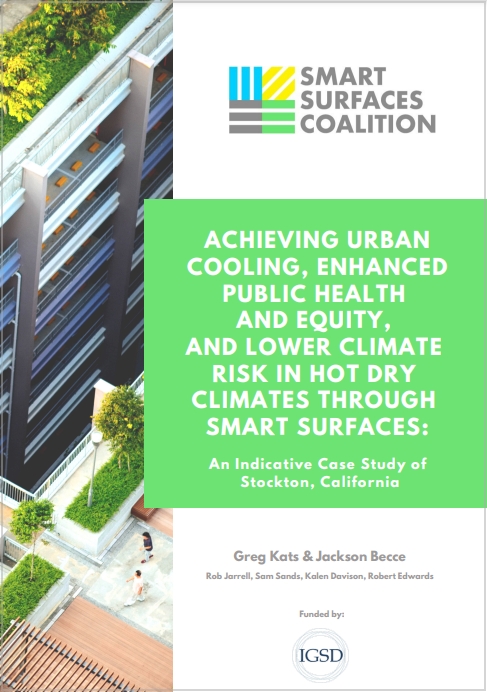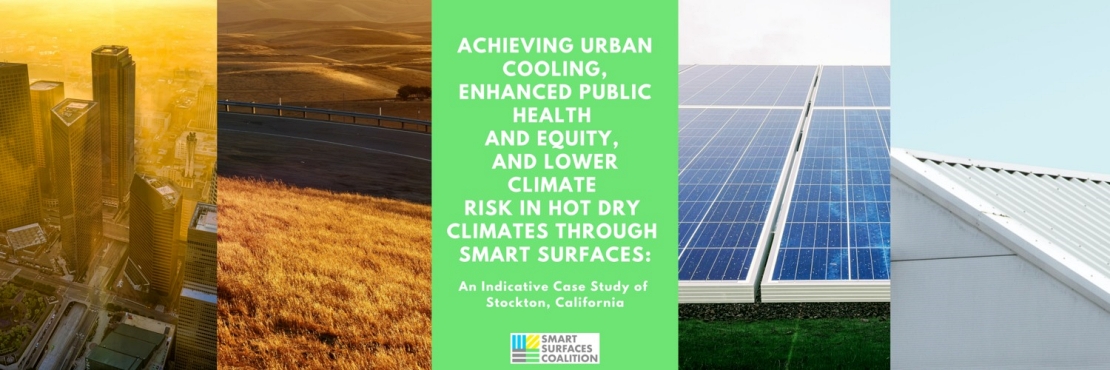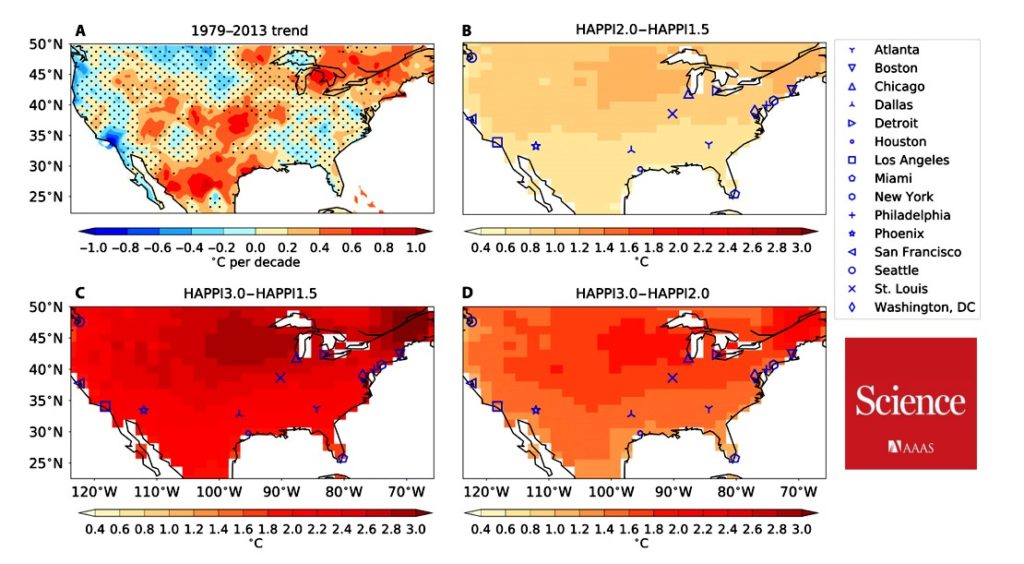Staff of Smart Surfaces Coalition writes:
Groundbreaking report by coalition of leading health, city policy, energy, planning, equity, and architecture groups demonstrates that Smart Surfaces are cost effective in reversing soaring city temperatures, slowing climate change, and delivering a more equitable future for Stockton and other cities in California.
Cities across the U.S and the world continue to suffer from record heat waves and deadly flooding. June was the hottest month on record and climate projections estimate the worst is yet to come, and California is front and center to these issues. The Smart Surfaces Coalition released a landmark report today detailing how cities can deploy Smart Surfaces to continue to decarbonize while cutting urban heat, advancing equity, creating jobs, and improving public health. Smart Surfaces, like reflective, porous, and green surfaces, solar photovoltaics (PV) and trees, are surfaces that more effectively manage two critical challenges cities face: severe heat and rainfall/ flooding.
“We know that this summer’s devastating heatwaves were driven by climate change. As we contend with the far-reaching effects of the climate crisis, there are proven, cost-effective solutions that allow cities globally to cool themselves even as the world warms,” said Greg Kats, CEO of the Smart Surfaces Coalition. “City-wide Smart Surfaces allow cities to become cooler, reduce contribution to climate change, advance equity, protect local economies, and become healthier and more livable.”
Like many cities in California and around the world, Stockton is a mid-sized, diverse city in a hot- and mixed-dry climate with equity, heat, and flooding challenges. So, these results are both regionally and globally applicable.
Benefits to Stockton of broad adoption of Smart Surfaces include:
- 2.92°F summer peak temperature reduction in downtown Stockton
- $777 million net present value from adoption of Smart Surfaces
- Benefit-cost ratio of 6.9:1—with net savings to the city from the first year
- Create more than 16,000 job years (817 full-time jobs) over 30-year analysis
- 4.58 million tonnes of CO2e emissions reduced over 30 years
Urban areas are suffering from increasingly lethal heat waves as sunlight is absorbed and re-emitted by dark surfaced buildings, roads, and other types of infrastructure. These dark, impervious surfaces not only raise temperatures—making cities 9˚F warmer in the summer on average—but also increase flooding, mold, and water pollution, all of which contribute to serious health risks.
 “Climate change is the greatest public health crisis of our lifetime and is an especially grave and immediate threat to urban communities, particularly lower income communities, which are at a higher risk of heat related injury,” said Dr. Georges C. Benjamin, M.D., Executive Director of the American Public Health Association. “The Smart Surfaces Coalition offers a transformative and cost-effective way to slow global warming and make cities cooler and healthier. Smart Surfaces are also an important strategy to mitigate the health risk from extreme heat in a cost-effective way—it must be adequately funded, rapidly implemented, and brought to scale.”
“Climate change is the greatest public health crisis of our lifetime and is an especially grave and immediate threat to urban communities, particularly lower income communities, which are at a higher risk of heat related injury,” said Dr. Georges C. Benjamin, M.D., Executive Director of the American Public Health Association. “The Smart Surfaces Coalition offers a transformative and cost-effective way to slow global warming and make cities cooler and healthier. Smart Surfaces are also an important strategy to mitigate the health risk from extreme heat in a cost-effective way—it must be adequately funded, rapidly implemented, and brought to scale.”
California is at the frontline of the climate crisis and has already set ambitious goals to cut greenhouse gas emissions. However, despite ambitious climate policies, public support, innovative programs, and committed leadership, a recent audit from the California Air Resources Board indicated that the State will fall short of meeting the 2030 goal” of a 40% reduction in greenhouse gas emissions from 1990 levels by 2030 “unless emissions reductions occur at a faster pace.” Retaining its position as a global climate leader means California must move faster to electrify buildings and decarbonize large industry than other states. By adopting Smart Surfaces state-wide, California can continue to be a leader in decarbonization, meet their climate objectives on time, improve air quality and public health, stabilize the grid, and advance equity.
“California is trying to solve multiple problems simultaneously: rising heat, inequality, clean air and water, and making cities and towns more resilient and sustainable. What this Stockton report demonstrates is that Smart Surfaces is a very effective and cost-effective way to address all these challenges. We can no longer take a business-as-usual approach to city planning and public investment; Smart Surfaces is an urgently needed alternative” said Dennis Murphy, Director of Water & Sustainable Life at Sustainable Silicon Valley, former Chair of USGBC California. “The Smart Surface Coalition’s study offers great clarity in solving the tricky math of valuing urban and suburban surfaces, which is critical for governments trying to stretch their budget dollars longer and wider. The Stockton case study demonstrates a very effective pathway for urban cooling, equity, and resilience, and demonstrates how we can put this into action across California’s hot and dry climates that are suffering and need help now. We have a choice between suffering and thriving; Californians should choose to prioritize health, equity, and prosperity, and adopt this strategy ASAP.”
“City-wide Smart Surfaces allow cities to become cooler, reduce contribution to climate change, advance equity, protect local economies, and become healthier and more livable.”
Greg Kats
CEO of the Smart Surfaces Coalition
Accelerating climate change in combination with increased attention to environmental justice issues—including around communities of color—is also creating a rapidly emerging set of risks for cities. Marginalized, low-income, and BIPOC communities too often bear the brunt of the large health and economic costs of dark, impervious surfaces. The largest cooling, air quality, and health benefits of Smart Surfaces accrue in low-income and minority neighborhoods. If Californian cities are to advance equity, cut urban heat, and meet their objectives on climate, health, jobs, and economic performance, then Smart Surfaces adoption would be the only solution to do so cost-effectively.
“I became angry that my community was hotter because of specific policies that invested in wealthy neighborhoods but failed to invest in Black and lower-income neighborhoods. It angered me that the choice to exercise and be outdoors that was afforded to wealthy communities was denied to my own” said William H. Lamar IV, Pastor of Metropolitan African Methodist Episcopal Church. “By making almost all surfaces reflective, porous and/or green, we can make communities – including those in which I have served as pastor—far cooler, healthier, and more livable, allowing people to be outdoors in the summer and to thrive, regardless of where they live.”
The analysis, funded by the Institute for Governance and Sustainable Development (IGSD), supported the generation of a Smart Surfaces customized Stockton-specific online analytic engine to model multiple adoption targets and timeframes, and test, compare, and optimize Smart Surfaces adoption scenarios. The analysis evaluated deployment of seven distinct Smart Surfaces, including cool roofs, reflective parking, reflective roads, urban trees, and solar PV.
Please follow this link for the full report.
###
About the Smart Surfaces Coalition
The Smart Surfaces Coalition is committed to the rapid, global adoption of Smart Surfaces to enable cities to thrive despite climate threats, save cities billions of dollars, create jobs, decrease heat, reduce flood risk, slow global warming, and improve city livability, health, and equity. For more information, visit SmartSurfacesCoalition.org and follow us on LinkedIn and Twitter.
 Greenroofs.comConnecting the Planet + Living Architecture
Greenroofs.comConnecting the Planet + Living Architecture









